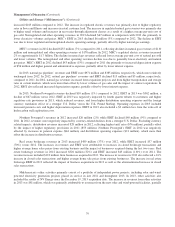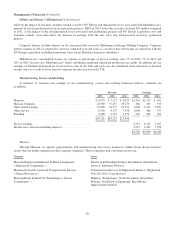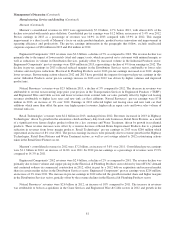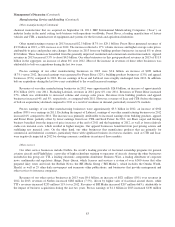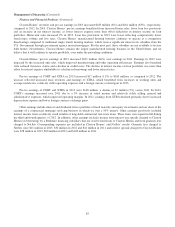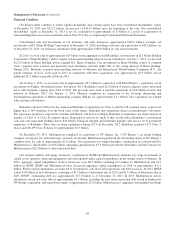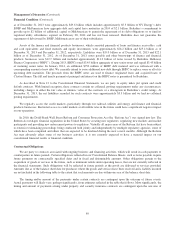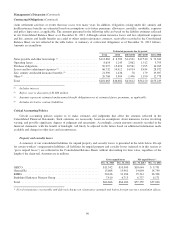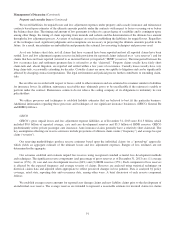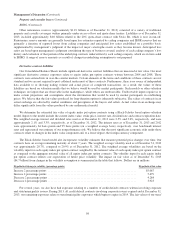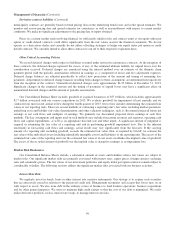Berkshire Hathaway 2013 Annual Report Download - page 91
Download and view the complete annual report
Please find page 91 of the 2013 Berkshire Hathaway annual report below. You can navigate through the pages in the report by either clicking on the pages listed below, or by using the keyword search tool below to find specific information within the annual report.Management’s Discussion (Continued)
Financial Condition (Continued)
as of December 31, 2013 were approximately $29.6 billion which includes approximately $5.3 billion of NV Energy’s debt.
BNSF and MidAmerican have aggregate debt and capital lease maturities in 2014 of $2.1 billion. Berkshire’s commitment to
provide up to $2 billion of additional capital to MidAmerican to permit the repayment of its debt obligations or to fund its
regulated utility subsidiaries expired on February 28, 2014 and has not been renewed. Berkshire does not guarantee the
repayment of debt issued by BNSF, MidAmerican or any of their subsidiaries.
Assets of the finance and financial products businesses, which consisted primarily of loans and finance receivables, cash
and cash equivalents and fixed maturity and equity investments, were approximately $26.2 billion and $25.4 billion as of
December 31, 2013 and December 31, 2012, respectively. Liabilities were $19.0 billion as of December 31, 2013 and $22.1
billion as of December 31, 2012. As of December 31, 2013, notes payable and other borrowings of finance and financial
products businesses were $12.7 billion and included approximately $11.2 billion of notes issued by Berkshire Hathaway
Finance Corporation (“BHFC”). During 2013, BHFC issued $3.45 billion aggregate of new senior notes and repaid $3.45 billion
of maturing senior notes. In January 2014, an additional $750 million of BHFC debt matured and was refinanced with a
corresponding amount of new debt. We currently intend to issue additional new debt through BHFC to replace some or all of its
upcoming debt maturities. The proceeds from the BHFC notes are used to finance originated loans and acquired loans of
Clayton Homes. The full and timely payment of principal and interest on the BHFC notes is guaranteed by Berkshire.
As described in Note 12 to the Consolidated Financial Statements, we are party to equity index put option and credit
default contracts. With limited exception, these contracts contain no collateral posting requirements under any circumstances,
including changes in either the fair value or intrinsic value of the contracts or a downgrade in Berkshire’s credit ratings. At
December 31, 2013, the net liabilities recorded for such contracts were approximately $5.3 billion and we had no collateral
posting requirements.
We regularly access the credit markets, particularly through our railroad, utilities and energy and finance and financial
products businesses. Restricted access to credit markets at affordable rates in the future could have a significant negative impact
on our operations.
In 2010, the Dodd-Frank Wall Street Reform and Consumer Protection Act (the “Reform Act”) was signed into law. The
Reform Act reshapes financial regulations in the United States by creating new regulators, regulating new markets and market
participants and providing new enforcement powers to regulators. Virtually all major areas of the Reform Act have been subject
to extensive rulemaking proceedings being conducted both jointly and independently by multiple regulatory agencies, some of
which have been completed and others that are expected to be finalized during the next several months. Although the Reform
Act may adversely affect some of our business activities, it is not currently expected to have a material impact on our
consolidated financial results or financial condition.
Contractual Obligations
We are party to contracts associated with ongoing business and financing activities, which will result in cash payments to
counterparties in future periods. Certain obligations reflected in our Consolidated Balance Sheets, such as notes payable, require
future payments on contractually specified dates and in fixed and determinable amounts. Other obligations pertain to the
acquisition of goods or services in the future, such as minimum rentals under operating leases, that are not currently reflected in
the financial statements. Such obligations will be reflected in future periods as the goods are delivered or services provided.
Amounts due as of the balance sheet date for purchases where the goods and services have been received and a liability incurred
are not included in the following table to the extent that such amounts are due within one year of the balance sheet date.
The timing and/or amount of the payments under certain contracts are contingent upon the outcome of future events.
Actual payments will likely vary, perhaps significantly, from estimates reflected in the table that follows. Most significantly, the
timing and amount of payments arising under property and casualty insurance contracts are contingent upon the outcome of
89


